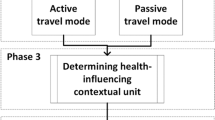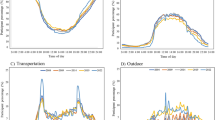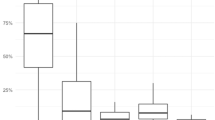Abstract
The TEACH Project obtained subjects' time-location information as part of its assessment of personal exposures to air toxics for high school students in two major urban areas. This report uses a longitudinal modeling approach to characterize the association between demographic and temporal predictors and the subjects' time-location behavior for three microenvironments — indoor-home, indoor-school, and outdoors. Such a longitudinal approach has not, to the knowledge of the authors, been previously applied to time-location data. Subjects were 14- to 19-year-old, self reported non-smokers, and were recruited from high schools in New York, NY (31 subjects: nine male, 22 female) and Los Angeles, CA (31 subjects: eight male, 23 female). Subjects reported their time-location in structured 24-h diaries with 15-min intervals for three consecutive weekdays in each of winter and summer-fall seasons in New York and Los Angeles during 1999–2000. The data set contained 15,009 observations. A longitudinal logistic regression model was run for each microenvironment where the binary outcome indicated the subject's presence in a microenvironment during a 15-min period. The generalized estimating equation (GEE) technique with alternating logistic regressions was used to account for the correlation of observations within each subject. The multivariate models revealed complex time-location patterns, with subjects predominantly in the indoor-home microenvironment, but also with a clear influence of the school schedule. The models also found that a subject's presence in a particular microenvironment may be significantly positively correlated for as long as 45 min before the current observation. Demographic variables were also predictive of time-location behavior: for the indoor-home microenvironment, having an afterschool job (OR=0.67 [95% confidence interval: 0.54:0.85]); for indoor-school, living in New York (0.42 [0.29:0.59]); and for outdoor, being 16-year-old (0.80 [0.67:0.96]), 17-year-old (0.71 [0.54:0.92]), and having an afterschool job (1.29 [1.07:1.56]).
This is a preview of subscription content, access via your institution
Access options
Subscribe to this journal
Receive 6 print issues and online access
$259.00 per year
only $43.17 per issue
Buy this article
- Purchase on Springer Link
- Instant access to full article PDF
Prices may be subject to local taxes which are calculated during checkout




Similar content being viewed by others
References
Adair J.H., and Spengler J.D. Assessing activity patterns for air pollution exposure research. In: Starks T.H. (Ed.). Proceedings of the Research Planning Conference on Human Activity Patterns (EPA/600/4-89/004) 1989a.
Adair JH, and Spengler JD Time activity and exposure assessment: the six-city indoor air quality experience. 82nd Annual Meeting and Exposition of the Air and Waste Management Association, [Anonymous, editor], 1989b.
Akland G, Hartwell T, Johnson T, and Whitmore R Measuring human exposure to carbon monoxide in Washington, DC, and Denver, Colorado during the winter of 1982–1983. Environ Sci Technol 1985: 19: 911–918.
Breslow N., and Clayton D. Approximate inference in generalized linear mixed models. J Am Stat Assoc 1993: 88 (421): 9–25.
Carey V., Zeger S.L., and Diggle P. Modelling multivariate binary data with alternating logistic regressions. Biometrika 1993: 80 (3): 517–526.
Diggle P.J., Liang K.Y., and Zeger S.L. Analysis of Longitudinal Data. Clarendon Press, Oxford, 1994.
Echols S., MacIntosh D., Hammerstrom K., and Ryan P. Temporal variability of microenvironmental time budgets in Maryland. J Expos Anal Environ Epidem 1999: 9: 502–512.
Elgethun K., Fenske R.A., Yost M.G., and Palcisko G.J. Time-location analysis for exposure assessment studies of children using a novel global positioning system instrument. Environ Health Perspect 2003: 111 (1): 115–122.
Freeman N., Waldman J., and Lioy P. Evaluation of a daily diary designed to identify exposure sources. 82nd Annual Meeting and Exposition of the Air and Waste Management Association, [Anonymous, editor], 1989.
Friedenreich C.M., Courneya K.S., Neilson H.K., Matthews C.E., Willis G., Irwin M., Troiano R., and Ballard-Barbash R. Reliability and validity of the past year total physical activity questionnaire. Am J Epidemiol 2006.
Glen G., and Shadwick D. Final Technical Report on the Analysis of Carbon Monoxide Exposures for Fourteen Cities using HAPEM — MS3, Report for ManTech Environmental Technology, 1998.
Glen G Details of the HAPEM — MS2 Exposure Model. Report for ManTech Environmental Technology 1994.
Jantunen M.J., Hänninen O., Katsoyanni K., Knöppel H., Künzli N., Lebret E., Maroni M., Saarela K., Srám R., and Zmirou D. Air pollution exposure in European cities: the EXPOLIS study. J Expo Sci Environ Epidemiol 1998: 8 (4): 495–518.
Jantunen M.J., Katsoyanni K., Knöppel H., Künzli N., Lebret E., Maroni M., Saarela K., Srám R., and Zmirou D. Final Report: Air Pollution Exposure in European Cities: The EXPOLIS Study, National Public Health Institute KTL, (Kansanterveyslaitoksen julkaisuja B16/1999), 1999.
Johnson T A Study of Personal Exposure to Carbon Monoxide in Denver, Colorado. US Environmental Protection Agency, 1983.
Johnson T, Capel J, and McCoy M Estimation of Ozone Exposures Experienced by Urban Residents using a Probabilistic Version of NEM and 1990 Population Data. Report for International Technology Air Quality Services, 1996a.
Johnson T., Capel J., McCoy M., and Warnasch J. Estimation of Ozone Exposures Experienced by Outdoor Workers in Nine Urban Areas using a Probabilistic Version of NEM. Report for International Technology Air Quality Services, 1996b.
Johnson T., Long T., and Ollison W. A survey of prospective technologies for collecting human activity data. In: Foley G., Fuerst R.G., Jayanty R.K.M., Hunike E., and Pashayan D.V. (Eds.), USEPA/AWMA International Symposium on the Measurement of Toxic and Related Air Pollutants 2000.
Kaur S., Clark R.D.R., Walsh P.T., Arnold S.J., Colvile R.N., and Nieuwenhuijsen M.J. Exposure visualisation of ultrafine particle counts in a transport microenvironment. Atmosp Environ 2006: 40 (2): 386–398.
Kinney P.L., Chillrud S.N., Ramstrom S., Ross J., and Spengler J.D. Exposures to multiple air toxics in New York City. Environ Health Perspect 2002: 110 (Suppl 4): 539–546.
Klepeis N.E., Nelson W.C., Ott W.R., Robinson J.P., Tsang A.M., Switzer P., Behar J.V., Hern S.C., and Engelmann W.H. The National Human Activity Pattern Survey (NHAPS): a resource for assessing exposure to environmental pollutants. J Expos Anal Environ Epidemiol 2001: 11 (3): 231–252.
Leech J.A., Wilby K., and McMullen E. Environmental tobacco smoke exposure patterns: a subanalysis of the Canadian Human Time-Activity Pattern Survey. Can J Public Health 1999: 90 (4): 244–249.
Leech J.A., Wilby K., McMullen E., and Laporte K. The Canadian Human Activity Pattern Survey: report of methods and population surveyed. Chronic Dis Can 1996: 17 (3–4): 118–123.
Liang K.Y., and Zeger S.L. Longitudinal data analysis using generalized linear models. Biometrika 1986: 73: 13–22.
Lichtenstein C., and Wyzga R. An activity pattern survey of asthmatics. In: Starks T. (Ed.), 1989 pp. 9-1-9-16.
McCullagh P., and Nelder J.A. Generalized Linear Models, 2nd Edition. Chapman and Hall, London, 1989.
McCurdy T., Glen G., Smith L., and Lakkadi Y. The national exposure research laboratory's consolidated human activity database. J Expo Anal Environ Epidemiol 2000: 10 (6 Part 1): 566–578.
McCurdy T., and Graham S. Using human activity data in exposure models: analysis of discriminating factors. J Expo Anal Environ Epidemiol 2003: 13: 294–317.
Quakenboss J., Spengler J., Kanarek M., Letz R., and Duffy C. Personal exposure to nitrogen dioxide: relationship to indoor/outdoor air quality and activity patterns. Environ Sci Technol 1986: 20: 775–783.
Robinson J., and Thomas J. Time Spent in Activities, Locations, and Microenvironments: A California-National Comparison. US Environmental Protection Agency, 1991.
Robinson J Estimating Activity and Location Time Expenditures from Human Activity Data: Comparison of Denver-Washington TEAM Activity Data with the 1987–88 California and 1985 National Data. Survey Research Center, University of Maryland, Maryland, USA, 1991.
Robinson J. Time diary research and human exposure assessment: some methodological considerations. Atmos Environ 1988: 22: 2085–2092.
Robinson J., Wiley J., Piazza T., Garrett K., and Cirksena K. Activity Patterns of California Residents and their Implications for Potential Exposure to Pollution. California Air Resources Board, 1989.
Robinson J.P., and Silvers A. Measuring potential exposure to environmental pollutants: time spent with soil and time spent outdoors. J Expo Anal Environ Epidemiol 2000: 10 (4): 341–354.
SAS Institute. Statistical Analysis System (SAS) 8.2 TS020. SAS Institute, Cary, NC, 2001.
Sax S.N., Bennett D.H., Chillrud S.N., Kinney P.L., and Spengler J.D. Differences in source emission rates of volatile organic compounds in inner-city residences of New York City and Los Angeles. J Expo Anal Environ Epidemiol 2004: 14 (Suppl 1): S95–109.
Schwab M., Colome S.D., Spengler J.D., Ryan P.B., and Billick I.H. Activity patterns applied to pollutant exposure assessment: data from a personal monitoring study in Los Angeles. Toxicol Indus Health 1990: 6 (6): 517–532.
Schwab M., McDermott A., and Spengler J.D. Using longitudinal data to understand children's activity patterns in an exposure context: data from the Kanawha County Health Study. Environ Int 1992: 18: 173–189.
Schwab M., Terblanche A.P., and Spengler J.D. Self-reported exertion levels on time/activity diaries: application to exposure assessment. J Expos Anal Environ Epidemiol 1991: 1 (3): 339–356.
Stock T., and Morandi M. A comparative evaluation of self-reported and independently observed activity patterns in an air pollution health effects study. In: Starks T. (Ed.), 1989.
US Environmental Protection Agency. Air Pollutants Exposure Model (APEX) 4.0. Research Triangle Park, NC, 2005.
Wiley J., Robinson J., Cheng Y., Piazza T., Stork L., and Pladsen K. Study of Children's Activity Patterns. California Air Resources Board, 1991a.
Wiley J., Robinson J., Piazza T., Garrett K., Cirksena K., Cheng Y., and Martin G. Activity Patterns of California Residents. California Air Resources Board, 1991b.
Acknowledgements
We thank the students and staff of the A Philip Randolph High School of New York City and the Jefferson High School of Los Angeles. Data were collected under a Contract NUATRC-96-01B provided by the Mickey Leland National Urban Air Toxics Center to Professors PL Kinney and JD Spengler. Additional support provided by National Institute of Environmental Health Sciences (NIEHS) grants to Columbia University's Center for Environmental Health in Northern Manhattan (NIEHS-ES09089) and the Columbia Center for Children's Environmental Health (NIEHS E09600 and US EPA R827027), as well as the Harvard NIEHS Center Grant (NIEHS-ES000002) and the Akira Yamaguchi endowment fund at the Harvard School of Public Health.
Author information
Authors and Affiliations
Corresponding author
Additional information
Notice — The US Environmental Protection Agency through its Office of Research and Development funded and managed the research described here under Contract 68-D-99-011 to Battelle Memorial Institute. It has been subjected to Agency review and approved for publication.
Supplementary Information accompanies the paper on the Journal of Exposure Analysis and Environmental Epidemiology website (http://www.nature.com/jes).
Supplementary information
Rights and permissions
About this article
Cite this article
deCastro, B., Sax, S., Chillrud, S. et al. Modeling time-location patterns of inner-city high school students in New York and Los Angeles using a longitudinal approach with generalized estimating equations. J Expo Sci Environ Epidemiol 17, 233–247 (2007). https://doi.org/10.1038/sj.jes.7500504
Received:
Accepted:
Published:
Issue Date:
DOI: https://doi.org/10.1038/sj.jes.7500504
Keywords
This article is cited by
-
Distributions and determinants of time spent outdoors among school-age children in China
Journal of Exposure Science & Environmental Epidemiology (2022)
-
Impact of IEEE 802.15.4 Communication Settings on Performance in Asynchronous Two Way UWB Ranging
International Journal of Wireless Information Networks (2017)
-
Longitudinal variability of time-location/activity patterns of population at different ages: a longitudinal study in California
Environmental Health (2011)
-
Analyses of school commuting data for exposure modeling purposes
Journal of Exposure Science & Environmental Epidemiology (2010)



